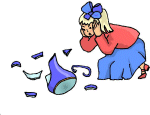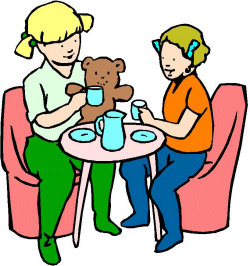Copyright © University of Cambridge. All rights reserved.
'Path of Discovery Series 3: I Do and I Understand' printed from https://nrich.maths.org/
Show menu
See also the previous articles in the series - Part 1 and Part 2.
There is a well known saying,
Consider what life would be like if we were only able to experience the first two elements of this saying. We could listen to and see new experiences. We could 'think things through' and make conclusions, which may or may not be reinforced by things we see and hear later. But we would be unable to speak about our thoughts and have them challenged or accepted, and we would be unable to touch
and handle what we see.
From our earliest days we use our sense of touch as an important tool in our efforts to learn about the world. Watch a young baby when he is given an object to hold. The object is rarely held still. It is passed from one hand to the other. It is put in the mouth. It is put down and picked up. Unknowingly, the child is learning the geometry and characteristics of this particular object. Facts that
are stored for comparison with other objects he will encounter later.

Growing children instinctively use touch to help them learn. The need to handle an object as well as see it is universal, - a fact borne out by the equally universal adult cry, 'Don't touch!'.
Even as adults we have this need to touch in order to learn. Think about when you are shopping for clothes or furniture, say. You may be able to see the object but you will automatically touch it to gain another perspective of what it is like.
Active learning
Children are always learning. After all, in their first 16/18/21 years they have several million years of evolutionary knowledge to catch up on! Before they can use reading and writing as tools to gain knowledge, they explore their world with all their senses, to find out about the objects around them.
We teach children to read and write because it enables us to impart facts quickly and efficiently, and allows them opportunities to communicate. But while we enable children to gain by using these skills, we should also continue to provide opportunities to learn and to consolidate learning through speech, touch and 'play'.
Seeing numbers
Mankind's need to invent numbers arises from a desire to keep track of his possessions, to measure distances from place to place, and to measure the passing of time. The things to be counted came first, the names and symbols for 'how many' followed later. Given that our number system took many thousands of years to develop, perhaps we shouldn't be in too much of a hurry to get children to think about number in a totally abstract way.

Learning about number starts in an aural way. Children learn number names through rhymes and songs. They can then apply these names to counting objects. By the beginning of Year 1 most children will be able to accurately count ten objects, but this does not necessarily mean they will understand what counting and numbers are. For instance, imagine we taught children to recite 'Tinker, tailor, soldier, sailor, etc.' and to match each word to a toy as they pointed along a line of teddies, say. Would the children have any notion of how many teddies there are? One-to-one counting can only be understood as counting, if it is related to 'how many?', 'how much?', 'how long?', etc..
We have to supply plenty of contexts of relating number names to amounts of things. This can be done through counting and comparing amounts, using the words 'more', 'fewer', and 'enough'. For example, suppose a child has four teddies and three cups. He should be able to count the teddies and cups. By giving each teddy a cup he should be able to tell if there are 'more teddies' or 'more cups'. (Be aware he may interpret 'more' as meaning 'taking up more space' or 'being more spread out'.) He should also be able to decide if there are 'enough' cups to give one to each teddy.
Numbers can also be explored by discovering the increasing nature of each number (amount). Look at rows of beads on a counting frame, they neatly show how each number (name) represents 'one more than' the previous number. Stern apparatus (or equivalent) when placed as steps in the tray also gives a satisfyingly visual and tactile way of finding out about the nature of number. Numicom by Image Learning Systems Ltd also provides children with a visual and tactile method of understanding number.
Writing maths
Traditionally, when a child shows he knows the names of numbers and is able to count accurately, he progresses to addition and subtraction, and later multiplication and division. However, before that stage is reached and at the same time as the child is learning about what numbers are, we introduce the further complication of squiggles (numerals) to represent number names. It is worth remembering that the child is going through two quite separate learning processes and may easily have problems connecting the right number (numeral) to the right number (amount or name).
'Arithmetic' in these early years could all be done in an oral and practical manner (because the numbers involved are comparatively small). A child may be able to explain what 'four and three make' in the context of 'how many teddies/counters/pencils do you have if you start with four and then get three more?' (particularly if he has the apparatus to demonstrate the situation). However, if he is posed the same question in an abstract situation, and if he lacks the knowledge of the symbolic language of mathematics you may be mistakenly led to believe otherwise.
The ability to use the symbolic language of mathematics is essential as the mathematical concepts become more complex and the manipulation of numbers develops into a more abstract activity. But at this early stage the necessity to learn written maths arises from education's requirement for evidence and records of achievement. A hundred years ago writing was the only available method for recording such evidence. Now, with tape recorders and cameras readily available, perhaps, for some children, these would be more appropriate means of keeping records.
Keep on touching
So, at the same time as teaching children to recognise numerals, explaining the elegance of the place value system of our numbers, and introducing the special symbols for the mathematical operations, we should bear in mind that the understanding of number is the priority. This may mean children should be allowed to use 'apparatus', so that they can physically handle the numbers involved in their calculations, for longer, or across a wider ability band, than is currently the norm. It may seem that some children are then making slower progress than would be expected. However, if their progress leads to a deeper comprehension than would have been achieved previously, this can only be beneficial for the children.
It is also worth remembering that there are some children who will respond more readily to an abstract approach to maths, than to a plodding and rigid apparatus-based approach. They may have mastered abstract counting and their one-to-one counting may be accurate but slow. These children can blossom if they are allowed to use the number pairs they have formed 'in their head', rather than being restrained by having to use apparatus if they don't need to. The art is to recognise precisely what is the problem causing the child to struggle!
Not every child is going to become a mathematical genius, but every child has the right to understand the mathematics he is asked to do. By allowing children every chance to grasp (literally?!) mathematical ideas, maths will cease to be a subject of a mixture of magic and lucky guesses. Children will feel more confident when faced with the next challenge that the maths lesson presents, and fear and avoidance of all things mathematical may even become a thing of the past.